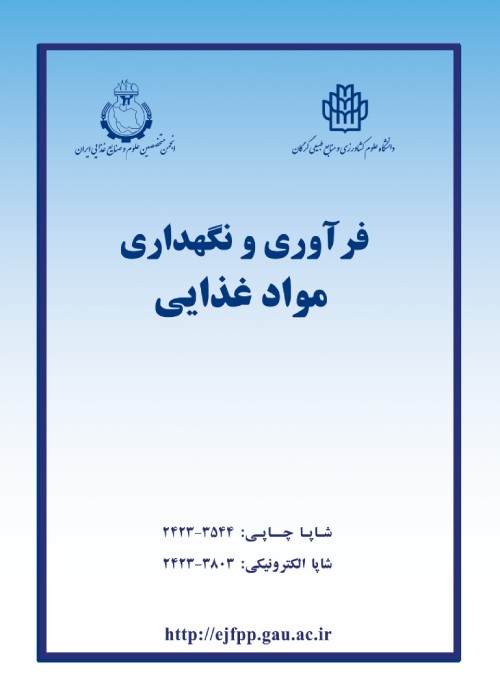Development of Adaptive Neuro-Fuzzy Inference System to Predict Mass Transfer Kinetics during Osmotic-Ultrasound Dehydration of Apple
Author(s):
Article Type:
Research/Original Article (دارای رتبه معتبر)
Abstract:
Background and objectives
Osmotic dehydration is a process of soaking products in an aqueous solution containing salt or sugar, which is normally applied to fruits and vegetables. The osmotic-ultrasound dehydration method can improve the quality of dehydrated products by increasing mass transfer rate and maintaining appearance properties. Although there are many statistical and mathematical methods for predicting mass transfer kinetics in the process of osmotic dehydration of agricultural products, but, the use of intelligent algorithms with desirable features has made significant progress in recent years. The main goal of this research is to predict the weight reduction percentage, solids gain percentage and water loss percentage of apple slices dehydrated by osmosis-ultrasound method using the adaptive neuro-fuzzy inference system or ANFIS.Materials and methods
The osmotic-ultrasound process was performed using the ultrasonic bath equipment (vCLEAN1-L6, Backer, Iran). The apple slices were immersed in the ultrasonic bath containing sucrose solutions of 30, 40, and 50 °Brix. The applied ultrasound powers were 0, 75, and 150 W, the ultrasound treatment time was 10, 20, 30, 40, 50, and 60 minutes, the device frequency was 40 kHz, and also, the system temperature was 50 °C. The moisture content of apple slices was calculated by oven at 105°C and during 5 hours. The ANFIS model with 3 inputs of ultrasonic power (at three levels of 0, 75, and 150 W), sucrose solution concentration (at three levels of 30, 40, and 50 °Brix), and ultrasound treatment time (at six times of 10, 20, 30, 40, 50, and 60 min) was developed to predict mass transfer kinetics during osmotic-ultrasound dehydration of apple slices.Results
The results of this research showed that with increasing the ultrasound power, ultrasound treatment time and osmotic solution concentration, the weight reduction percentage of the samples increased, which these changes was due to high moisture removal from the apple slices. The optimal ANFIS network structure includes three inputs (ultrasonic power, ultrasonic treatment time, and osmotic solution concentration), 48 input membership functions, 16 rules in the middle layer, 16 output membership functions, and an output response (weight reduction percentage, solids gain percentage, or water loss percentage). The coefficient of determination (r) values calculated for predicting weight reduction percentage, solids gain percentage and water loss percentage parameters using the ANFIS-based subtractive clustering algorithm were equal to 0.952, 0.927 and 0.961, respectively.Conclusion
The ANFIS system accurately estimated the output parameters of osmotic dehydration process of apple well; therefore, it is recommended to use this method in design and development of intelligent control systems for dehydration processes in agricultural products.Keywords:
Language:
Persian
Published:
Electronic Journal of Food Processing and Preservation, Volume:14 Issue: 4, 2023
Pages:
73 to 90
magiran.com/p2567760
دانلود و مطالعه متن این مقاله با یکی از روشهای زیر امکان پذیر است:
اشتراک شخصی
با عضویت و پرداخت آنلاین حق اشتراک یکساله به مبلغ 1,390,000ريال میتوانید 70 عنوان مطلب دانلود کنید!
اشتراک سازمانی
به کتابخانه دانشگاه یا محل کار خود پیشنهاد کنید تا اشتراک سازمانی این پایگاه را برای دسترسی نامحدود همه کاربران به متن مطالب تهیه نمایند!
توجه!
- حق عضویت دریافتی صرف حمایت از نشریات عضو و نگهداری، تکمیل و توسعه مگیران میشود.
- پرداخت حق اشتراک و دانلود مقالات اجازه بازنشر آن در سایر رسانههای چاپی و دیجیتال را به کاربر نمیدهد.
In order to view content subscription is required
Personal subscription
Subscribe magiran.com for 70 € euros via PayPal and download 70 articles during a year.
Organization subscription
Please contact us to subscribe your university or library for unlimited access!



